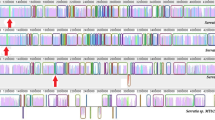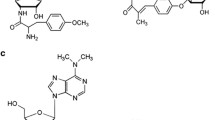Abstract
TOL plasmid pWW0 from Pseudomonas putida mt-2 encodes catabolic enzymes required for the oxidation of toluene and xylenes. The structural genes for these catabolic enzymes are clustered into two operons, the xylCMABN operon, which encodes a set of enzymes required for the transformation of toluene/xylenes to benzoate/toluates, and the xylXYZLTEGFJQKIH operon, which encodes a set of enzymes required for the transformation of benzoate/toluates to Krebs cycle intermediates. The latter operon can be divided physically and functionally into two parts, the xylXYZL cluster, which is involved in the transformation of benzoate/toluates to (methyl)catechols, and the xylTEGFJQKIH cluster, which is involved in the transformation of (methyl)catechols to Krebs cycle intermediates. Genes isofunctional to xylXYZL are present in Acinetobacter calcoaceticus, and constitute a benzoate-degradative pathway, while xylTEGFJQKIH homologous encoding enzymes of a methylphenol-degradative pathway and a naphthalene-degradative pathway are present on plasmid pVI150 from P. putida CF600, and on plasmid NAH7 from P. putida PpG7, respectively. Comparison of the nucleotide sequences of the xylXYZLTEGFJQKIH genes with other isofunctional genes suggested that the xylTEGFJQKIH genes on the TOL plasmid diverged from these homologues 20 to 50 million years ago, while the xylXYZL genes diverged from the A. calcoaceticus homologues 100 to 200 million years ago. In codons where amino acids are not conserved, the substitution rate in the third base was higher than that in synonymous codons. This result was interpreted as indicating that both single and multiple nucleotide substitutions contributed to the amino acid-substituting mutations, and hence to enzyme evolution. This observation seems to be general because mammalian globin genes exhibit the same tendency.
Similar content being viewed by others
References
Assinder SJ, Williams PA (1990) The TOL plasmids: determinants of the catabolism of toluene and the xylenes. Adv Microbial Physiol 31:1–69
Babiuk LA, Paul EA (1970) The use of fluorescein isothiocyanate in the determination of the bacterial biomass of grassland soil. Can J Microbiol 16:57–62
Bartilson M, Shingler V (1989) Nucleotide sequence and expression of the catechol 2,3-dioxygenase-encoding gene of phenol catabolizing Pseudomonas CF600. Gene 85:233–238
Bartilson M, Nordlund I, Shingler V (1990) Location and gene organization of the dimethylphenol catabolic genes of Pseudomonas CF600. Mol Gen Genet 220:294–300
Benjamin RC, Voss JA, Kunz DA (1991) Nucleotide sequence of xylE from the TOL pDKI plasmid and structural comparison with isofunctional catechol-2,3-dioxygenase genes from TOL pWW0 and NAH7. J Bacteriol 173:2724–2728
Cairns J, Overbaugh J, Miller S (1988) The origin of mutants. Nature 335:142–145
Drake JW (1991a) A constant rate of spontaneous mutation in DNA-based microbes. Proc Natl Acad Sci USA 88:7160–7164
Drake JW (1991b) Spontaneous mutation. Annu Rev Genet 25:125–146
Echols H, Goodman MF (1991) Fidelity mechanisms in DNA replication. Annu Rev Biochem 60:477–511
Ghosal D, You I-S, Gunsalus IC (1987) Nucleotide sequence and expression of gene nahH of plasmid NAH7 and homology with gene xylE of TOL pWWO. Gene 55:19–28
Hagström A (1984) Aquatic bacteria: measurements and significance of growth. In: Klug MJ, Reddy CA (eds) Current perspectives in microbial ecology. American Society for Microbiology, Washington, DC, pp 495–501
Hall BG (1990) Directed evolution of a bacterial operon. BioEssays 12:551–558
Hall BG (1991) Adaptive evolution that requires multiple spontaneous mutations: mutations involving base substitutions. Proc Natl Acad Sci USA 88:5882–5886
Harayama S, Rekik M (1990) The meta cleavage operon of TOL degradative plasmid pWW0 comprises 13 genes. Mol Gen Genet 221:113–120
Harayama S, Timmis KN (1989) Catabolism of aromatic hydrocarbons by Pseudomonas. In: Hopwood DA, Chater KE (eds) Genetics of bacterial diversity. Academic Press, New York, pp 151–174
Harayama S, Timmis KN (1992) Aerobic biodegradation of aromatic hydrocarbons by bacteria. In: Sigel H, Sigel A (eds) Metal ions in biological systems, vol 28. Marcel Dekker, New York, pp 99–156
Harayama S, Rekik M, Wasserfallen A, Bairoch A (1987) Evolutionary relationships between catabolic pathways for aromatics conservation of gene order and nucleotide sequences of catechol oxidation genes of pWWO and NAH7 plasmids. Mol Gen Genet 210:241–247
Harayama S, Rekik M, Wubbolts M, Rose K, Leppik RA, Timmis KN (1989a) Characterization of five genes in the upper-pathway operon of TOL plasmid pWW0 from Pseudomonas putida and identification of the gene products. J Bacteriol 171:5048–5055
Harayama S, Rekik M, Ngai K-L, Ornston LN (1989b) Physically associated enzymes produce and metabolize 2-hydroxy-2,4-dienoate, a chemically unstable intermediate formed in catechol metabolism via meta cleavage in Pseudomonas putida. J Bacteriol 171:6251–6258
Harayama S, Polissi A, Rekik M (1991a) Divergent evolution of chloroplast-type ferredoxins. FEBS Lett 285:85–88
Harayama S, Rekik M, Bairoch A, Neidle EL, Ornston LN (1991b) Potential DNA slippage structures acquired during evolutionary divergence of Acinetobacter calcoaceticus chromosomal benABC and Pseudomonas putida TOL pWW0 plasmid xylXYZ, gene encoding benzoate dioxygenases. J Bacteriol 173:7540–7548
Harayama S, Wasserfallen A, Cerdan P, Rekik M (1992) Mutational modification of the substrate specificity of catechol 2,3-dioxygenase encoded by TOL plasmid pWW0 of Pseudomonas putida. In: Galli E, Silver S, Witholt B (eds) Pseudomonas. Molecular biology and biotechnology. American Society for Microbiology, Washington DC, pp 223–230
Holmquist R (1972) Theoretical foundations for a quantitative approach to paleogenetics. Part 1: DNA. J Mol Evol 1:115–133
Horn JM, Harayama S, Timmis KN (1991) DNA sequence determination of the TOL plasmid (pWWO) xylGIJ genes of Pseudomonas putida: implications for the evolution of aromatic catabolism. Mol Microbiol 5:2459–2474
Keil H, Keil S, Williams PA (1987) Molecular analysis of regulatory and structural xyl genes of the TOL plasmid pWW53-4. J Gen Microbiol 133:1149–1158
Kimura M (1991) Recent development of the neutral theory viewed from the Wrightian tradition of theoretical population genetics. Proc Natl Acad Sci USA 88:5969–5973
Lawrence JG, Hard DL, Ochman H (1991) Molecular considerations in the evolution of bacterial genes. J Mol Evol 33:241–250
Maeda N, Smithies O (1986) The evolution of multigene families: human haptoglobin genes. Annu Rev Genet 20:81–108
Maniatis T, Fritsch EF, Sambrook J (1982) Molecular cloning. A laboratory manual. Cold Spring Harbor Laboratory Press, New York
Miyata T, Yasunaga T, Nishida T (1980) Nucleotide sequence divergence and functional constraint in mRNA evolution. Proc Natl Acad Sci USA 77:7328–7332
Nakai C, Kagamiyama H, Nozaki M, Nakazawa T, Inouye S, Ebina Y, Nakazawa A (1983) Complete nucleotide sequence of the metapyrocatechase gene on the TOL plasmid of Pseudomonas putida mt-2. J Biol Chem 258:2923–2928
Neidle EL, Hartnett C, Ornston LN, Bairoch A, Rekik M, Harayama S (1991) Nucleotide sequences of the Acinetobacter calcoaceticus benABC genes for benzoate 1,2-dioxygenase reveal evolutionary relationships among multicomponent oxygenases. J Bacteriol 173:5385–5395
Neidle E, Hartnett C, Ornston LN, Bairoch A, Rekik M, Harayama S (1992) Cis-diol dehydrogenases encoded by the TOL pWW0 plasmid xylL gene and the Acinetobacter calcoaceticus chromosomal benD gene are members of the short-chain alcohol dehydrogenase superfamily. Eur J Biochem 204:113–120
Nordlund I, Shingler V (1990) Nucleotide sequence of the meta-cleavage pathway enzymes 2-hydroxymuconic semialdehyde dehydrogenase and 2-hydroxymuconic semialdehyde hydroxylase from Pseudomonas CF600. Biochim Biophys Acta 1049:227–230
Nordlund I, Powlowski J, Shingler V (1990) Complete nucleotide sequences and polypeptide analysis of multicomponent phenol hydroxylase from Pseudomonas sp strain CF600. J Bacteriol 172:6826–6833
Ochman H, Wilson AC (1987) Evolution in bacteria: evidence for a universal substitution rate in cellular genomes. J Mol Evol 26:74–86
Osborne DJ, Pickup RW, Williams PA (1988) The presence of two complete homologous meta pathway operons on TOL plasmid pWW53. J Gen Microbiol 134:2965–2975
Sanger F, Nicklen S, Coulson AR (1977) DNA sequencing with chain-terminating inhibitors. Proc Natl Acad Sci USA 74:5463–5467
Shaw LE, Williams PA (1988) Physical and functional mapping of two cointegrate plasmids derived from RP4 and TOL plasmid pDKI. J Gen Microbiol 134:2463–2474
Shingler V, Powlowski J, Marklund U (1992) Nucleotide sequence and functional analysis of the complete phenol/3,4-dimethylphenol catabolic pathway of Pseudomonas sp strain CF600. J Bacteriol 174:711–724
Wasserfallen A, Rekik M, Harayama S (1991) A Pseudomonas putida strain able to degrade m-toluate in the presence of 3-chlorocatechol. Bio/Technology 9:296–298
Williams PA, Gibb LE, Keil H, Osborne DJ (1988) Organization of and relationships between catabolic genes of TOL plasmids, In: Hagedorn SR, Hanson RS, Kunz DA (eds) Microbial metabolism and the carbon cycle. A symposium in honor of Stanley Dagley. Harwood Academic Publishers, Chur, Switzerland, pp 339–358
Williams PA, Assinder SJ, Shaw LE (1990) Construction of hybrid xylE genes between the two duplicate homologous genes from TOL plasmid pWW53: comparison of the kinetic properties of the gene products. J Gen Microbiol 136:1583–1589
Williams PA, Assinder SJ, de Marco P, O'Donnell KJ, Poh CL, Shaw LE, Winson MK (1992) Catabolic gene duplications in TOL plasmids. In: Galli E, Silver S, Witholt B (eds) Pseudomonas. Molecular biology and biotechnology. American Society for Microbiology, Washington DC, pp 341–352
Worsey MJ, Williams PA (1975) Metabolism of toluene and xylenes by Pseudomonas putida (arvilla) mt-2: evidence for a new function of the TOL plasmid. J Bacteriol 124:7–13
Yen K-M, Gunsalus IC (1982) Plasmid gene organization: Naphthalene/salicylate oxidation. Proc Natl Acad Sci USA 79:874–878
You I-S, Ghosal D, Gunsalus IC (1991) Nucleotide sequence analysis of the Pseudomonas putida PpG7 salicylate hydroxylase gene (nahG) and its 3′-flanking region. Biochemistry 30:1635–1641
Author information
Authors and Affiliations
Additional information
Communicated by K. Isono
Rights and permissions
About this article
Cite this article
Harayama, S., Rekik, M. Comparison of the nucleotide sequences of the meta-cleavage pathway genes of TOL plasmid pWW0 from Pseudomonas putida with other meta-cleavage genes suggests that both single and multiple nucleotide substitutions contribute to enzyme evolution. Molec. Gen. Genet. 239, 81–89 (1993). https://doi.org/10.1007/BF00281605
Received:
Accepted:
Issue Date:
DOI: https://doi.org/10.1007/BF00281605




